Food labeling is a minefield. Bright colors and straplines such as “no added fat” and “high in protein” really draw people in. Marketing campaigns designed to add familiarity to brand name products, means we’re more than comfortable to just grab and go when in need of a snack, all without a second thought. We trust what we’re told and most often remain ignorant to the rest of the nutritional data that’s usually hidden away in the fine print.
It’s law in the UK to include all of the nutritional information on pre-packed food and the Gov.UK website states that “legislation sets requirements for food labels in the UK and aims to ensure food labels are an honest presentation of food. The requirements in place to ensure consistency for the industry and for consumers”. That said, tactical design and a vested interest in ensuring the product is as appealing as possible, means that often these details can quite easily be overlooked.
This got us thinking… If health food packaging was “redesigned” to explicitly depict the more alarming details, would we still buy and eat the products in such volume?
So, we’ve taken a selection of well-known products that are specifically marketed as a healthier option and redesigned their labels to represent some of the less desirable traits they hold such as sugar content, which can have a huge impact on our day-to-day health and well being. We have to say, we were quite shocked by some of the findings!
Kelloggs Fruit n’ Fibre
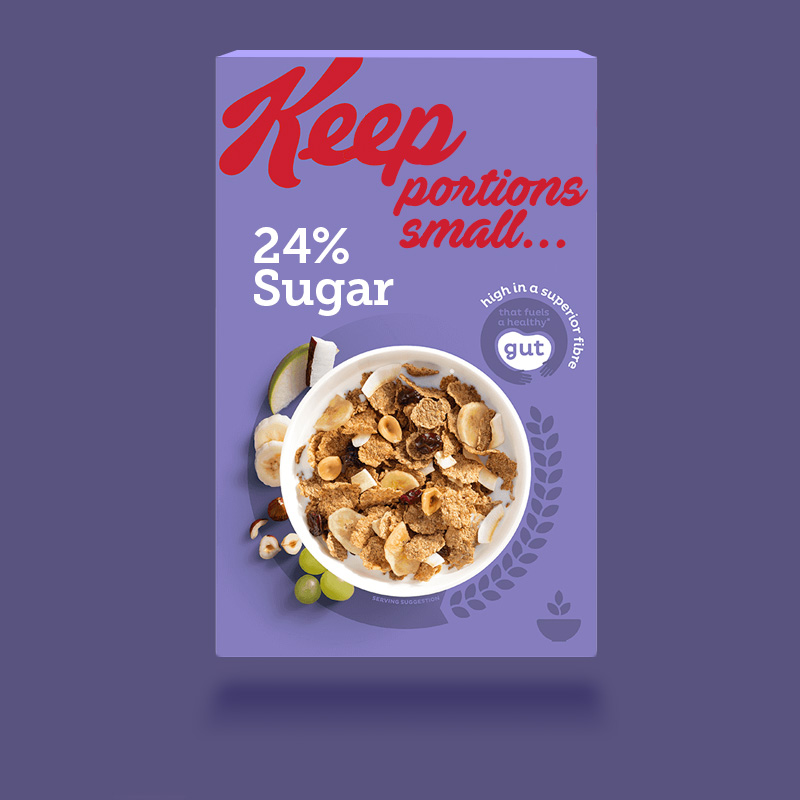 Kellogg’s Fruit n’ Fibre has been on the shelves for decades, marketed as a healthy cereal that looks after your digestive system. Sure, getting fruit in wherever you can is important and fibre is no bad thing either, but what they leave off the front of the box is the sugar content. A recommended serving is 40g but who’s getting their scales out first thing in the morning? Of those 40 grams, 9.6 grams is sugar and most of that figure is added sugar too. That’s 24% of your bowl and around a third of your daily recommended amount. All before you’ve even started your day.
Kellogg’s Fruit n’ Fibre has been on the shelves for decades, marketed as a healthy cereal that looks after your digestive system. Sure, getting fruit in wherever you can is important and fibre is no bad thing either, but what they leave off the front of the box is the sugar content. A recommended serving is 40g but who’s getting their scales out first thing in the morning? Of those 40 grams, 9.6 grams is sugar and most of that figure is added sugar too. That’s 24% of your bowl and around a third of your daily recommended amount. All before you’ve even started your day.
Tropicana Orange Juice
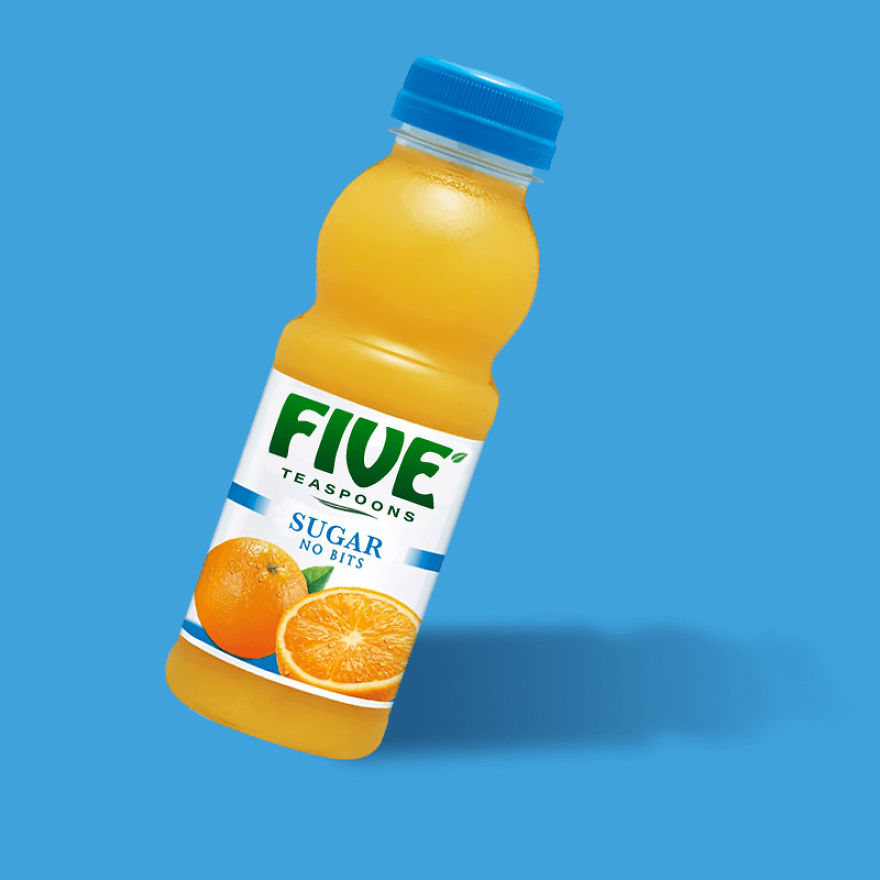 It’s now quite well known that fruit juices have a bad habit of being absolutely loaded with sugar. Fruit itself is high in natural sugars, and producers will often add even more. Tropicana like to make a point of the fact they don’t add sugar to their juice which, don’t get us wrong, is a good thing. However, a 250ml bottle of the good stuff holds 22g of sugar. Over two-thirds of your recommended daily amount. A single orange has about 8 grams of sugar in comparison, so a small 250ml bottle is roughly the equivalent of eating 3 oranges at once. All whilst trading some of that nutritional content for more sugar.
It’s now quite well known that fruit juices have a bad habit of being absolutely loaded with sugar. Fruit itself is high in natural sugars, and producers will often add even more. Tropicana like to make a point of the fact they don’t add sugar to their juice which, don’t get us wrong, is a good thing. However, a 250ml bottle of the good stuff holds 22g of sugar. Over two-thirds of your recommended daily amount. A single orange has about 8 grams of sugar in comparison, so a small 250ml bottle is roughly the equivalent of eating 3 oranges at once. All whilst trading some of that nutritional content for more sugar.
Walkers Sunbites
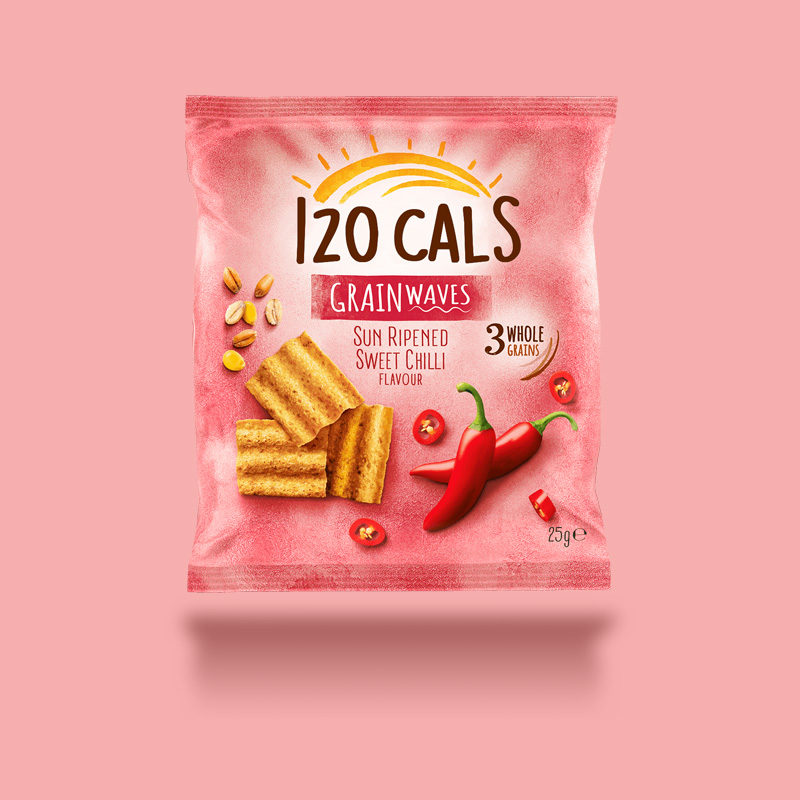 To the untrained eye, Walkers’ Sunbites look positively wholesome, light and a healthy snack. They emphasise their natural flavours and whole grains, but not their nutritional content. A 25g pack contains 15g of carbohydrates, 5 grams of fat and weighing in at 120kcal, they aren’t quite as wholesome as they appear when you compare them to other readily available snacks.
To the untrained eye, Walkers’ Sunbites look positively wholesome, light and a healthy snack. They emphasise their natural flavours and whole grains, but not their nutritional content. A 25g pack contains 15g of carbohydrates, 5 grams of fat and weighing in at 120kcal, they aren’t quite as wholesome as they appear when you compare them to other readily available snacks.
Muller Light Yoghurt
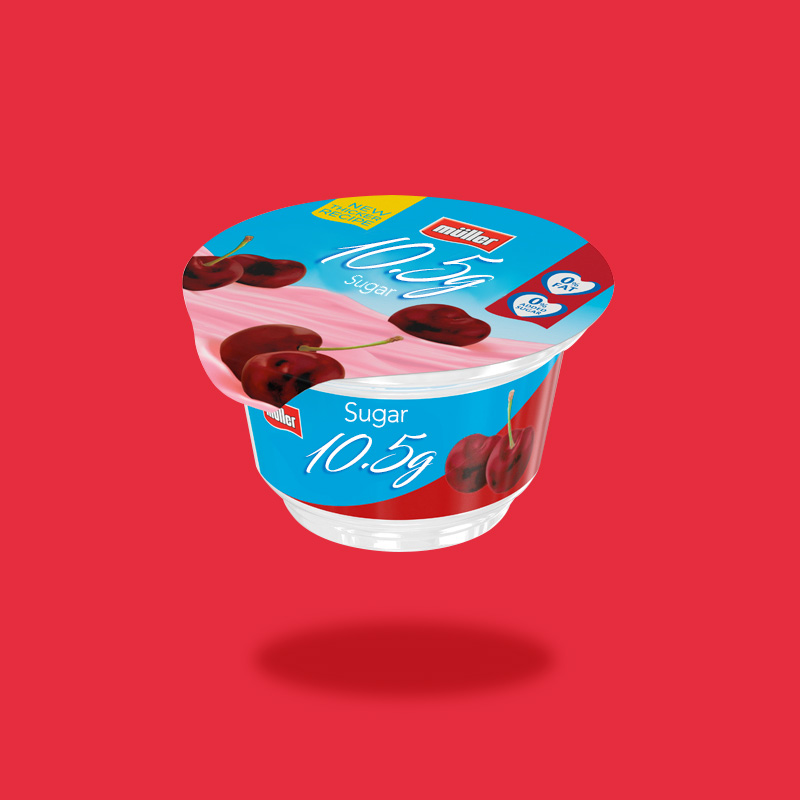 Yoghurt makes for a great snack or breakfast food, but unfortunately tends to contain undesirable levels of fat and sugar. So you’ll notice that almost every yoghurt brand will offer a 0% fat option alongside their full fat yoghurt. One of the most popular is Muller Light. With highlighted promises of no fat and no added sugar, you wouldn’t be blamed for grabbing this off the shelf at all. However, because they use fruit puree, this results in a good 10.5 grams of sugar in one 160g pot, a third of your daily amount. Consider this… if you eat a bowl of Fruit n’ Fibre with a side of Muller Light Yoghurt and a drink of Tropicana orange juice for your breakfast already puts you at 33% over your daily recommended amount of sugar, so tread carefully!
Yoghurt makes for a great snack or breakfast food, but unfortunately tends to contain undesirable levels of fat and sugar. So you’ll notice that almost every yoghurt brand will offer a 0% fat option alongside their full fat yoghurt. One of the most popular is Muller Light. With highlighted promises of no fat and no added sugar, you wouldn’t be blamed for grabbing this off the shelf at all. However, because they use fruit puree, this results in a good 10.5 grams of sugar in one 160g pot, a third of your daily amount. Consider this… if you eat a bowl of Fruit n’ Fibre with a side of Muller Light Yoghurt and a drink of Tropicana orange juice for your breakfast already puts you at 33% over your daily recommended amount of sugar, so tread carefully!
Bertolli Olive Spread
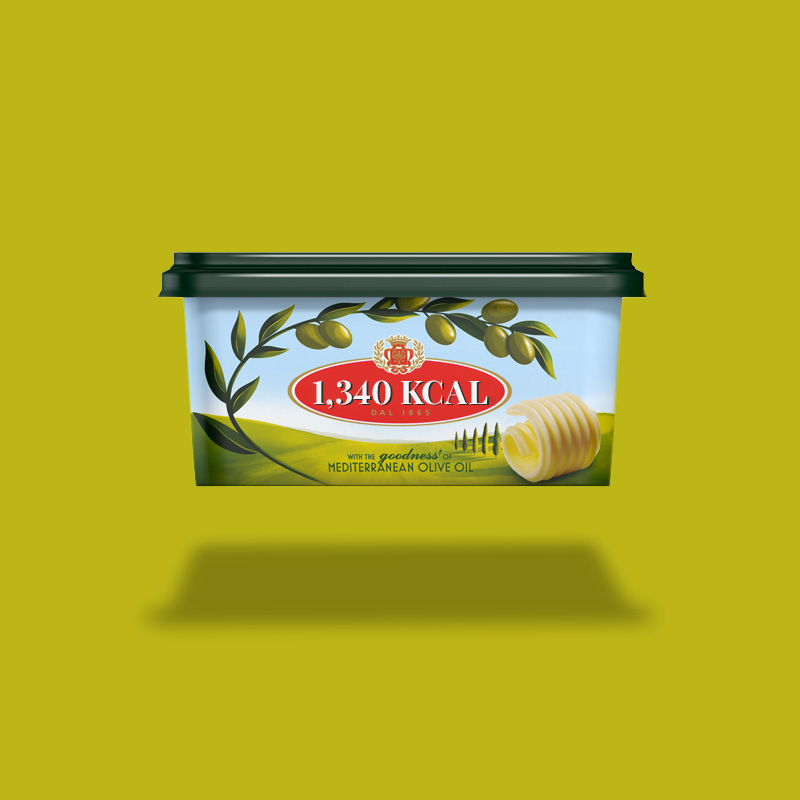 Olive spreads have long been marketed as a healthy alternative to butter, but Bertolli’s olive oil spread is actually only 21% olive oil. It’s also not really the health option you could be forgiven for thinking it is. A recommended serving is 10g, a bit skimpy by anyone’s standards, and within that are 59kcal. Compared to 74kcal for butter, the calorific difference is quite minute. When you consider that the olive spread has a whole host of preservatives, additives and emulsifiers, we’re not really faced with the goodness we think we are. With over 1,300kcal in a 250g tub, consider something like avocado or hummus which both have just over 400kcal for the same amount.
Olive spreads have long been marketed as a healthy alternative to butter, but Bertolli’s olive oil spread is actually only 21% olive oil. It’s also not really the health option you could be forgiven for thinking it is. A recommended serving is 10g, a bit skimpy by anyone’s standards, and within that are 59kcal. Compared to 74kcal for butter, the calorific difference is quite minute. When you consider that the olive spread has a whole host of preservatives, additives and emulsifiers, we’re not really faced with the goodness we think we are. With over 1,300kcal in a 250g tub, consider something like avocado or hummus which both have just over 400kcal for the same amount.
Nestle Milkybar
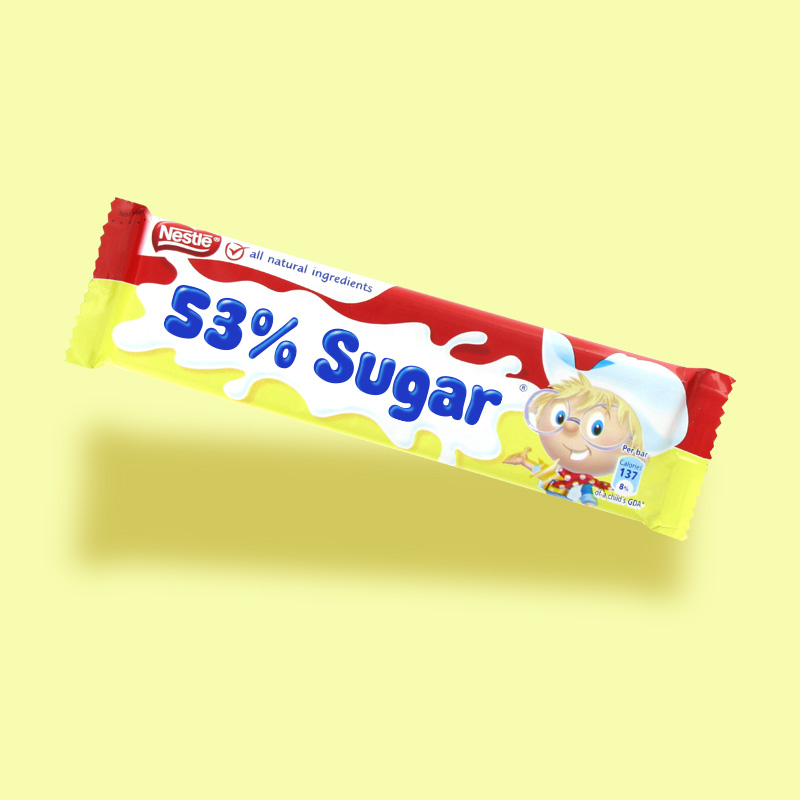 Milky Bar doesn’t pretend to be a healthy food, but it is widely considered to be the ‘better’ chocolate to give your children. And they do play up to that in their branding and advertising. In actual fact, a Milky Bar is over 53% sugar and 21g of a 25g bar is sugar and fat. Treats are treats and everyone deserves a bit of indulgence now and then, no matter how old you are, but it is one to be cautious with.
Milky Bar doesn’t pretend to be a healthy food, but it is widely considered to be the ‘better’ chocolate to give your children. And they do play up to that in their branding and advertising. In actual fact, a Milky Bar is over 53% sugar and 21g of a 25g bar is sugar and fat. Treats are treats and everyone deserves a bit of indulgence now and then, no matter how old you are, but it is one to be cautious with.
Weetabix On The Go
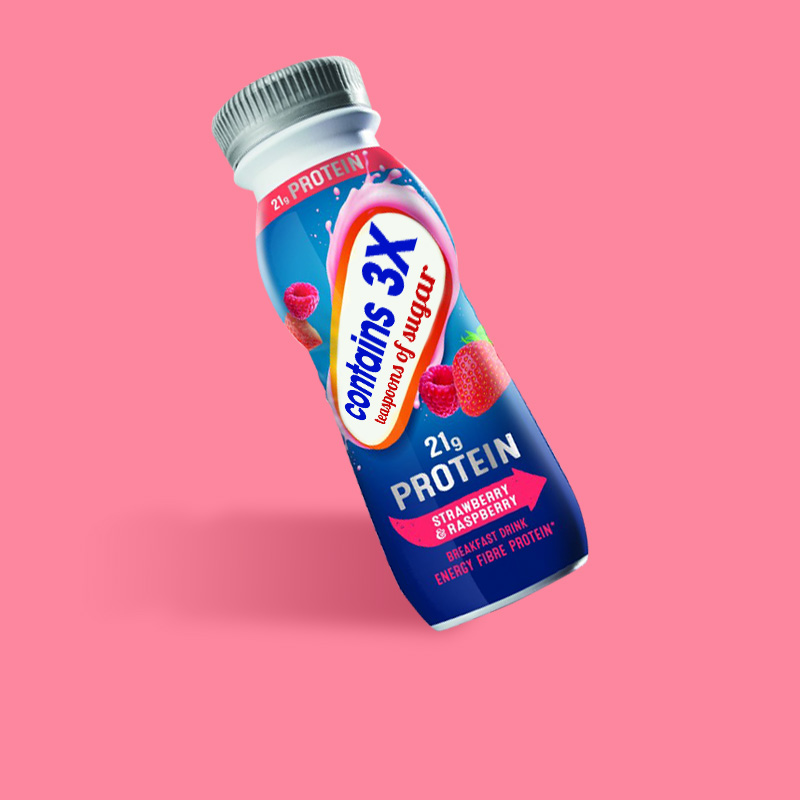 Lots of ‘breakfast on the go’ drinks have surfaced in recent years, aimed at a market of commuters and workers that need to fuel up on the move. The idea of breakfast in a drink is seriously appealing to many and the promise of added protein is alluring too. However, one 275ml drink contains a third of your recommended daily amount of sugar and the vast majority of adults don’t find it difficult to eat their recommended amount of protein whatsoever, so the added protein could be overkill. What’s the problem with too much protein? A large study concluded that excess protein led to a 49% increased risk of heart failure. It is possible to have too much of a good thing, after all.
Lots of ‘breakfast on the go’ drinks have surfaced in recent years, aimed at a market of commuters and workers that need to fuel up on the move. The idea of breakfast in a drink is seriously appealing to many and the promise of added protein is alluring too. However, one 275ml drink contains a third of your recommended daily amount of sugar and the vast majority of adults don’t find it difficult to eat their recommended amount of protein whatsoever, so the added protein could be overkill. What’s the problem with too much protein? A large study concluded that excess protein led to a 49% increased risk of heart failure. It is possible to have too much of a good thing, after all.
Nature Valley Protein Bars
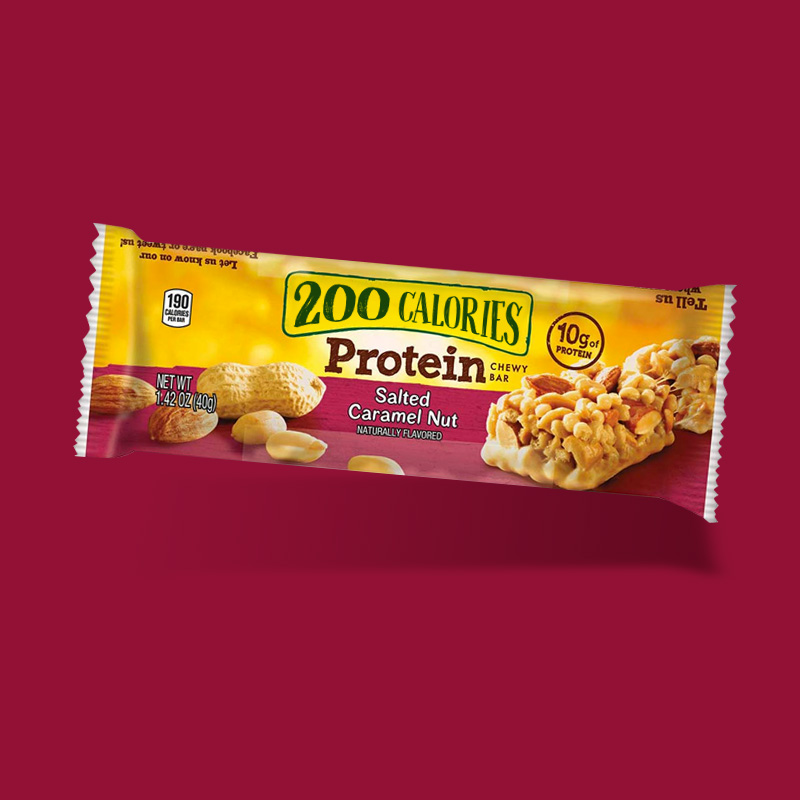 Looking at the Salted Caramel Nut Protein Chewy Bar in particular, the nutritional content also belies the wholesome branding of Nature Valley bars. A 40g bar has over 12 grams of fat which is a fifth of your daily allowance. Again, high protein levels aren’t necessarily something to shout about and unless you’re training heavily or a high performance athlete, is likely to be doing more harm than good.
Looking at the Salted Caramel Nut Protein Chewy Bar in particular, the nutritional content also belies the wholesome branding of Nature Valley bars. A 40g bar has over 12 grams of fat which is a fifth of your daily allowance. Again, high protein levels aren’t necessarily something to shout about and unless you’re training heavily or a high performance athlete, is likely to be doing more harm than good.
Belvita Breakfast Biscuits
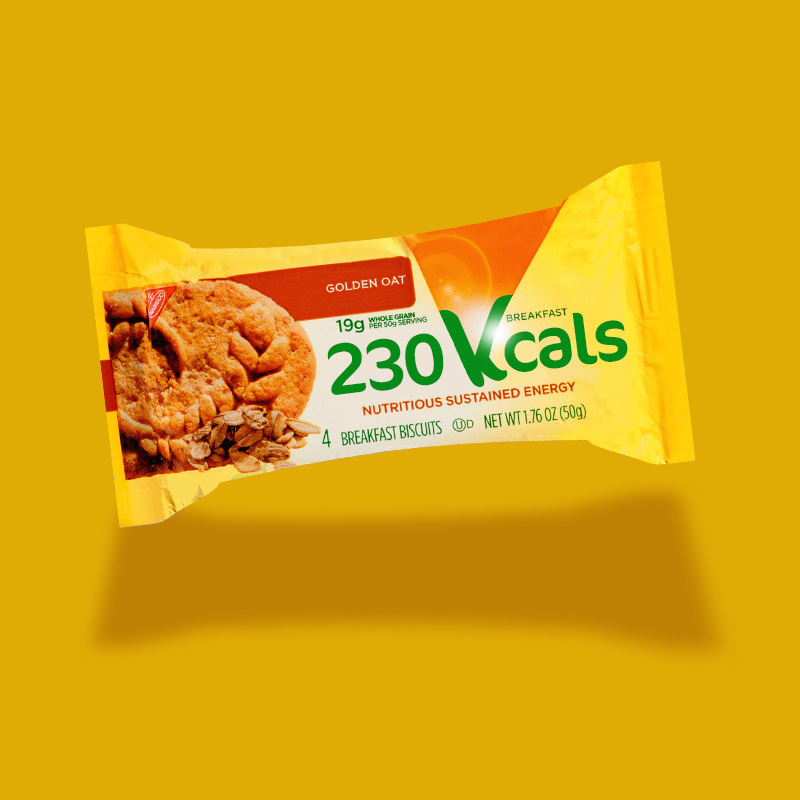 Biscuits that give you slow-release, sustained energy throughout the day sounds great, right? Study the nutritional value and you’ll find there are as many calories (230) in a pack of four biscuits as a standard chocolate bar. You may want to consider taking a walk on your lunch break to burn those off. Albeit, they aren’t as high in sugar as chocolate, but still contain nearly a third of your daily amount.
Biscuits that give you slow-release, sustained energy throughout the day sounds great, right? Study the nutritional value and you’ll find there are as many calories (230) in a pack of four biscuits as a standard chocolate bar. You may want to consider taking a walk on your lunch break to burn those off. Albeit, they aren’t as high in sugar as chocolate, but still contain nearly a third of your daily amount.
Danone Activia
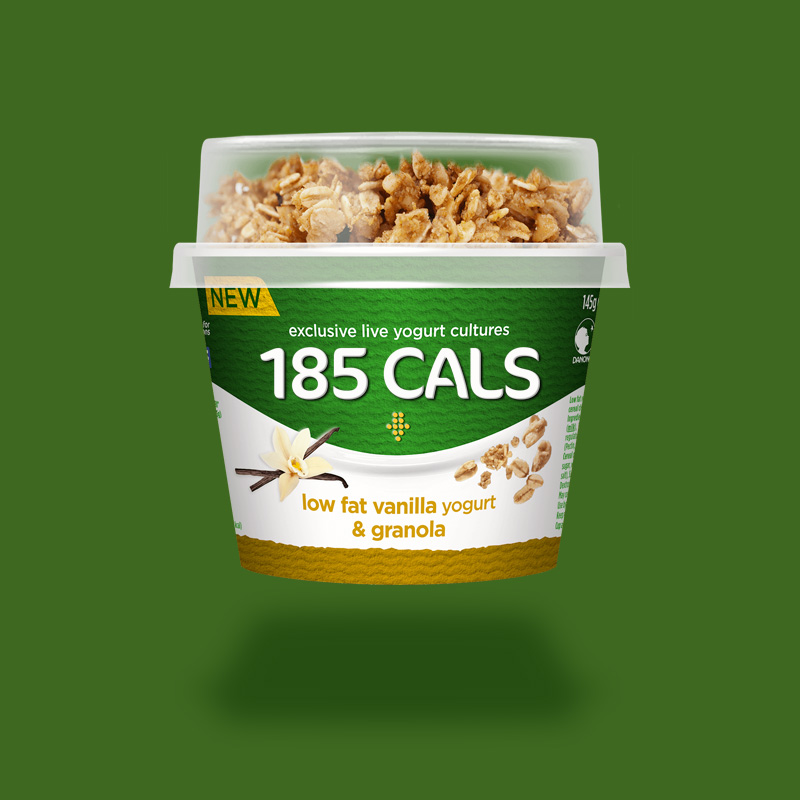
Danone’s Activia Yoghurt and Granola Pot has a little secret they don’t want you to know about. The Activia range has long been advertised as a healthy option that’s good for your gut. Credit where it’s due it is, as it says, low in fat. This doesn’t equate to being a healthy food though. This particular pot is holding over 18 grams of sugar, just shy of two-thirds of your daily allowance. If you’re having these for breakfast you’ll have to dodge as much sugar as you can for the rest of your day. This product is a prime example of how ‘low-fat’ products can be much more damaging in other ways.
Yakult Yoghurt Drink
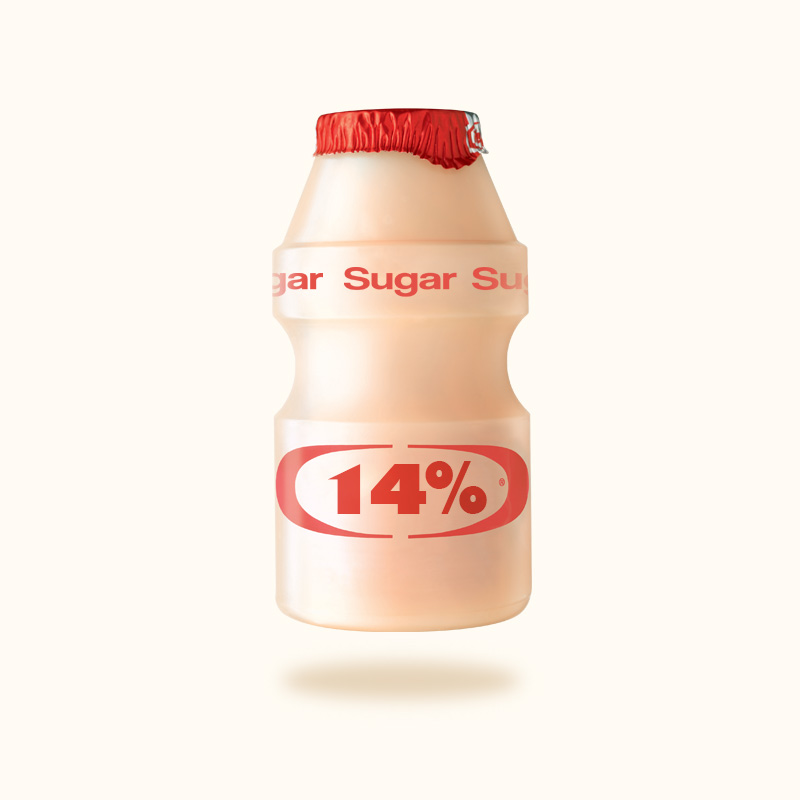 Not Yakult, too? Afraid so. There is some evidence that Yakult can help with your digestion so if that’s important to you, then just go forth with caution because one tiny 65ml bottle, little more than a shot’s worth, has 8.8 grams of sugar. Quite a stunning amount for such a small serving. If this was served in a 275ml bottle like Weetabix On The Go, this would have over 36 grams of sugar! Easily over your daily allowance.
Not Yakult, too? Afraid so. There is some evidence that Yakult can help with your digestion so if that’s important to you, then just go forth with caution because one tiny 65ml bottle, little more than a shot’s worth, has 8.8 grams of sugar. Quite a stunning amount for such a small serving. If this was served in a 275ml bottle like Weetabix On The Go, this would have over 36 grams of sugar! Easily over your daily allowance.
You’re more than welcome to use our images for your own content, all we ask is that you cite Amica International as the original source.
 Kellogg’s Fruit n’ Fibre has been on the shelves for decades, marketed as a healthy cereal that looks after your digestive system. Sure, getting fruit in wherever you can is important and fibre is no bad thing either, but what they leave off the front of the box is the sugar content. A recommended serving is 40g but who’s getting their scales out first thing in the morning? Of those 40 grams, 9.6 grams is sugar and most of that figure is added sugar too. That’s 24% of your bowl and around a third of your daily recommended amount. All before you’ve even started your day.
Kellogg’s Fruit n’ Fibre has been on the shelves for decades, marketed as a healthy cereal that looks after your digestive system. Sure, getting fruit in wherever you can is important and fibre is no bad thing either, but what they leave off the front of the box is the sugar content. A recommended serving is 40g but who’s getting their scales out first thing in the morning? Of those 40 grams, 9.6 grams is sugar and most of that figure is added sugar too. That’s 24% of your bowl and around a third of your daily recommended amount. All before you’ve even started your day.
 It’s now quite well known that fruit juices have a bad habit of being absolutely loaded with sugar. Fruit itself is high in natural sugars, and producers will often add even more. Tropicana like to make a point of the fact they don’t add sugar to their juice which, don’t get us wrong, is a good thing. However, a 250ml bottle of the good stuff holds 22g of sugar. Over two-thirds of your recommended daily amount. A single orange has about 8 grams of sugar in comparison, so a small 250ml bottle is roughly the equivalent of eating 3 oranges at once. All whilst trading some of that nutritional content for more sugar.
It’s now quite well known that fruit juices have a bad habit of being absolutely loaded with sugar. Fruit itself is high in natural sugars, and producers will often add even more. Tropicana like to make a point of the fact they don’t add sugar to their juice which, don’t get us wrong, is a good thing. However, a 250ml bottle of the good stuff holds 22g of sugar. Over two-thirds of your recommended daily amount. A single orange has about 8 grams of sugar in comparison, so a small 250ml bottle is roughly the equivalent of eating 3 oranges at once. All whilst trading some of that nutritional content for more sugar.
 To the untrained eye, Walkers’ Sunbites look positively wholesome, light and a healthy snack. They emphasise their natural flavours and whole grains, but not their nutritional content. A 25g pack contains 15g of carbohydrates, 5 grams of fat and weighing in at 120kcal, they aren’t quite as wholesome as they appear when you compare them to other readily available snacks.
To the untrained eye, Walkers’ Sunbites look positively wholesome, light and a healthy snack. They emphasise their natural flavours and whole grains, but not their nutritional content. A 25g pack contains 15g of carbohydrates, 5 grams of fat and weighing in at 120kcal, they aren’t quite as wholesome as they appear when you compare them to other readily available snacks.
 Yoghurt makes for a great snack or breakfast food, but unfortunately tends to contain undesirable levels of fat and sugar. So you’ll notice that almost every yoghurt brand will offer a 0% fat option alongside their full fat yoghurt. One of the most popular is Muller Light. With highlighted promises of no fat and no added sugar, you wouldn’t be blamed for grabbing this off the shelf at all. However, because they use fruit puree, this results in a good 10.5 grams of sugar in one 160g pot, a third of your daily amount. Consider this… if you eat a bowl of Fruit n’ Fibre with a side of Muller Light Yoghurt and a drink of Tropicana orange juice for your breakfast already puts you at 33% over your daily recommended amount of sugar, so tread carefully!
Yoghurt makes for a great snack or breakfast food, but unfortunately tends to contain undesirable levels of fat and sugar. So you’ll notice that almost every yoghurt brand will offer a 0% fat option alongside their full fat yoghurt. One of the most popular is Muller Light. With highlighted promises of no fat and no added sugar, you wouldn’t be blamed for grabbing this off the shelf at all. However, because they use fruit puree, this results in a good 10.5 grams of sugar in one 160g pot, a third of your daily amount. Consider this… if you eat a bowl of Fruit n’ Fibre with a side of Muller Light Yoghurt and a drink of Tropicana orange juice for your breakfast already puts you at 33% over your daily recommended amount of sugar, so tread carefully!
 Olive spreads have long been marketed as a healthy alternative to butter, but Bertolli’s olive oil spread is actually only 21% olive oil. It’s also not really the health option you could be forgiven for thinking it is. A recommended serving is 10g, a bit skimpy by anyone’s standards, and within that are 59kcal. Compared to 74kcal for butter, the calorific difference is quite minute. When you consider that the olive spread has a whole host of preservatives, additives and emulsifiers, we’re not really faced with the goodness we think we are. With over 1,300kcal in a 250g tub, consider something like avocado or hummus which both have just over 400kcal for the same amount.
Olive spreads have long been marketed as a healthy alternative to butter, but Bertolli’s olive oil spread is actually only 21% olive oil. It’s also not really the health option you could be forgiven for thinking it is. A recommended serving is 10g, a bit skimpy by anyone’s standards, and within that are 59kcal. Compared to 74kcal for butter, the calorific difference is quite minute. When you consider that the olive spread has a whole host of preservatives, additives and emulsifiers, we’re not really faced with the goodness we think we are. With over 1,300kcal in a 250g tub, consider something like avocado or hummus which both have just over 400kcal for the same amount.
 Milky Bar doesn’t pretend to be a healthy food, but it is widely considered to be the ‘better’ chocolate to give your children. And they do play up to that in their branding and advertising. In actual fact, a Milky Bar is over 53% sugar and 21g of a 25g bar is sugar and fat. Treats are treats and everyone deserves a bit of indulgence now and then, no matter how old you are, but it is one to be cautious with.
Milky Bar doesn’t pretend to be a healthy food, but it is widely considered to be the ‘better’ chocolate to give your children. And they do play up to that in their branding and advertising. In actual fact, a Milky Bar is over 53% sugar and 21g of a 25g bar is sugar and fat. Treats are treats and everyone deserves a bit of indulgence now and then, no matter how old you are, but it is one to be cautious with.
 Lots of ‘breakfast on the go’ drinks have surfaced in recent years, aimed at a market of commuters and workers that need to fuel up on the move. The idea of breakfast in a drink is seriously appealing to many and the promise of added protein is alluring too. However, one 275ml drink contains a third of your recommended daily amount of sugar and the vast majority of adults don’t find it difficult to eat their recommended amount of protein whatsoever, so the added protein could be overkill. What’s the problem with too much protein? A large study concluded that excess protein led to a 49% increased risk of heart failure. It is possible to have too much of a good thing, after all.
Lots of ‘breakfast on the go’ drinks have surfaced in recent years, aimed at a market of commuters and workers that need to fuel up on the move. The idea of breakfast in a drink is seriously appealing to many and the promise of added protein is alluring too. However, one 275ml drink contains a third of your recommended daily amount of sugar and the vast majority of adults don’t find it difficult to eat their recommended amount of protein whatsoever, so the added protein could be overkill. What’s the problem with too much protein? A large study concluded that excess protein led to a 49% increased risk of heart failure. It is possible to have too much of a good thing, after all.
 Looking at the Salted Caramel Nut Protein Chewy Bar in particular, the nutritional content also belies the wholesome branding of Nature Valley bars. A 40g bar has over 12 grams of fat which is a fifth of your daily allowance. Again, high protein levels aren’t necessarily something to shout about and unless you’re training heavily or a high performance athlete, is likely to be doing more harm than good.
Looking at the Salted Caramel Nut Protein Chewy Bar in particular, the nutritional content also belies the wholesome branding of Nature Valley bars. A 40g bar has over 12 grams of fat which is a fifth of your daily allowance. Again, high protein levels aren’t necessarily something to shout about and unless you’re training heavily or a high performance athlete, is likely to be doing more harm than good.
 Biscuits that give you slow-release, sustained energy throughout the day sounds great, right? Study the nutritional value and you’ll find there are as many calories (230) in a pack of four biscuits as a standard chocolate bar. You may want to consider taking a walk on your lunch break to burn those off. Albeit, they aren’t as high in sugar as chocolate, but still contain nearly a third of your daily amount.
Biscuits that give you slow-release, sustained energy throughout the day sounds great, right? Study the nutritional value and you’ll find there are as many calories (230) in a pack of four biscuits as a standard chocolate bar. You may want to consider taking a walk on your lunch break to burn those off. Albeit, they aren’t as high in sugar as chocolate, but still contain nearly a third of your daily amount.
 Danone’s Activia Yoghurt and Granola Pot has a little secret they don’t want you to know about. The Activia range has long been advertised as a healthy option that’s good for your gut. Credit where it’s due it is, as it says, low in fat. This doesn’t equate to being a healthy food though. This particular pot is holding over 18 grams of sugar, just shy of two-thirds of your daily allowance. If you’re having these for breakfast you’ll have to dodge as much sugar as you can for the rest of your day. This product is a prime example of how ‘low-fat’ products can be much more damaging in other ways.
Danone’s Activia Yoghurt and Granola Pot has a little secret they don’t want you to know about. The Activia range has long been advertised as a healthy option that’s good for your gut. Credit where it’s due it is, as it says, low in fat. This doesn’t equate to being a healthy food though. This particular pot is holding over 18 grams of sugar, just shy of two-thirds of your daily allowance. If you’re having these for breakfast you’ll have to dodge as much sugar as you can for the rest of your day. This product is a prime example of how ‘low-fat’ products can be much more damaging in other ways.
 Not Yakult, too? Afraid so. There is some evidence that Yakult can help with your digestion so if that’s important to you, then just go forth with caution because one tiny 65ml bottle, little more than a shot’s worth, has 8.8 grams of sugar. Quite a stunning amount for such a small serving. If this was served in a 275ml bottle like Weetabix On The Go, this would have over 36 grams of sugar! Easily over your daily allowance.
Not Yakult, too? Afraid so. There is some evidence that Yakult can help with your digestion so if that’s important to you, then just go forth with caution because one tiny 65ml bottle, little more than a shot’s worth, has 8.8 grams of sugar. Quite a stunning amount for such a small serving. If this was served in a 275ml bottle like Weetabix On The Go, this would have over 36 grams of sugar! Easily over your daily allowance.
